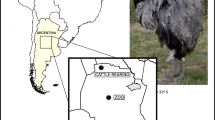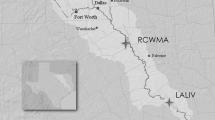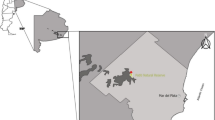Abstract
Persistent organochlorine pesticides (OCPs), such as dichlorodiphenyltrichloroethane (DDT) and its metabolites, hexachlorobenzene (HCB), α-, β-, and γ-hexachlorocyclohexane (HCH) isomers, together with polychlorinated biphenyl (PCB) congeners (IUPAC Nos. 28, 52, 101, 138, 153, and 180) were determined in tail feathers from 35 birds belonging to 15 species, all originating from the southwest of Iran (Khuzestan, coast of the Persian Gulf) and kept in museum collections. The patterns of organochlorine contaminants (OCs) in birds varied depending on their migratory behavior. Resident birds contained higher median PCB concentrations (<LOQ-151 ng/g feather) than HCHs, DDTs, and HCB. Locally migrating birds had higher median concentrations of HCHs (19–83 ng/g feather). In contrast, long-distance migrants had lower concentrations of HCB and HCHs. A positive correlation was observed among OCs in these birds, suggesting that trophic level, feeding strategy, and taxonomic group are influencing factors for the OC concentrations in bird feathers. An estimate of the risk associated suggests that levels of OCPs and PCBs were lower or close to the threshold reported to affect reproduction in 1990s.



Similar content being viewed by others
References
Altshul L, Covaci A, Hauser R (2004) The relationship between levels of PCBs and pesticides in human hair and blood: preliminary results. Environ Health Perspect 112:1193–1199
Bird D, Tucker P, Fox G, Lague P (1983) Synergistic effects of Aroclor 1254 and mirex on the semen characteristic of American kestrels. Arch Environ Contam Toxicol 12:633–640
Cooke AS, Bell AA, Haas MB (1982) Predatory birds. pesticides and pollution, Institute of Terrestrial Ecology, Cambridge
Covaci A, Schepens P (2001) Chromatographic aspects of the analysis of selected persistent organochlorine pollutants in human hair. Chromatographia 53:366–371. doi:10.1007/BF02490358
Covaci A, Tutudaki M, Tsatsakis AM, Schepens P (2002) Hair analysis: another approach for the assessment of human exposure to selected persistent organochlorine pollutants. Chemosphere 46:413–418. doi:10.1016/S0045-6535(01)00065-0
Dahmardeh Behrooz R, Esmaili-Sari A, Ghasempouri SM, Bahramifar N, Covaci A (2008) Organochlorine pesticide and polychlorinated biphenyl residues in feathers of birds from different trophic levels of South-West Iran. Environ Int (accepted)
Dauberschmidt C, Wennig R (1998) Organochlorine pollutants in human hair. J Anal Toxicol 22:610–611
Dauwe T, Jaspers V, Covaci A, Schepens P, Eens M (2005) Feathers as a non-destructive biomonitor for persistent organic pollutants. Environ Toxicol Chem 24:442–449. doi:10.1897/03-596.1
D’Havé H, Covaci A, Scheirs J, Schepens P, De Coen W (2005) Hair as an indicator of endogenous tissue levels of brominated flame retardants in mammals. Environ Sci Technol 39:6016–6020. doi:10.1021/es0507259
Gabrielsen GW, Skaare JU, Polder A, Bakken V (1995) Chlorinated hydrocarbons in glaucous gull (Larus hyberboreus). Sci Total Environ 160/161:337–346 doi:10.1016/0048-9697(95)04367-A
Giesy JP, Ludwig JP, Tillitt DE (1994) Dioxins, dibenzofurans, PCBs and colonial, fish-eating water birds. In: Schecter A (ed) Dioxins and health. Plenum Press, New York, pp 258–280
Hamelink JL (1977) Fish and chemicals: the process of accumulation. Annu Rev Pharmacol Toxicol 17:167–177. doi:10.1146/annurev.pa.17.040177.001123
Harper RG, Frick JA, Capparella AP et al (1996) Organochlorine pesticide contamination in neotropical migrant passerines. Arch Environ Contam Toxicol 31:386–390. doi:10.1007/BF00212677
Henriksen EO, Gabrielsen GW, Trudeau S, Wolkers J, Sagerup K, Skaare JU (2000) Organochlorines and possible biochemical effects in glaucous gull (Larus hyperboreus) from Bjørnøya, the Barents Sea. Arch Environ Contam Toxicol 38:234–243. doi:10.1007/s002449910031
Janssens E, Dauwe T, Bervoets L, Eens M (2001) Heavy metals and selenium in feathers of great tits (Parus major) along a pollution gradient. Environ Toxicol Chem 20:2815–2820. doi:10.1897/1551-5028(2001)020<2815:HMASIF>2.0.CO;2
Janz DM, Bellward GD (1996) In ovo 2, 3, 7, 8-tetrachlorodibenzo-pdioxin exposure in three avian species. Toxicol Appl Pharmacol 139:281–291. doi:10.1006/taap.1996.0167
Jaspers V, Dauwe T, Pinxten R, Bervoets L, Blust R, Eens M (2004) The importance of exogenous contamination on heavy metal levels in bird feathers. A field experiment with free-living great tits, Parus major. J Environ Monit 6:356–360. doi:10.1039/b314919f
Jaspers VLB, Covaci A, Van den Steen E, Eens M (2007a) Is external contamination with organic pollutants important for concentrations measured in bird feathers? Environ Int 33:766–772. doi:10.1016/j.envint.2007.02.013
Jaspers VLB, Voorspoels S, Covaci A, Eens M, Schepens P (2006) Can predatory bird feathers be used as a non-destructive biomonitoring tool of organic pollutants? Biol Lett 2:283–285. doi:10.1098/rsbl.2006.0450
Jaspers VLB, Voorspoels S, Covaci A, Lepoint G, Eens M (2007b) Evaluation of the usefulness of bird feathers as a non-destructive biomonitoring tool for organic pollutants: a comparative and meta-analytical approach. Environ Int 33:328–337. doi:10.1016/j.envint.2006.11.011
Koistinen J, Koivusaari J, Nuuja I, Paasivirta J (1995) PCDEs, PCBs, PCDDs and PCDFs in black guillemots and white-tailed eagles from the Baltic Sea. Chemosphere 30:1671–1684. doi:10.1016/0045-6535(95)00053-B
Kubiak TJ, Harris HJ, Smith LM et al (1989) Microcontaminants and reproductive impairment of the Forster’s tern on Green Bay, Lake Michigan 1983. Arch Environ Contam Toxicol 18:706–727. doi:10.1007/BF01225009
Kunisue T, Watanabe M, Subramanian A et al (2003) Accumulation feathers of persistent organochlorines in resident and migratory birds from Asia. Environ Pollut 125:157–172. doi:10.1016/S0269-7491(03)00074-5
Lorenzen A, Shutt JL, Kennedy SW (1997) Sensitivity of common tern (Sterna hirundo) embryo hepatocyte cultures to CYP1A induction and porphyry in accumulation by halogenated aromatic hydrocarbons and common tern egg extracts. Arch Environ Contam Toxicol 32:126–134. doi:10.1007/s002449900164
Mansoori J (1999) Field guide to birds of Iran. Publisher University, Tehran
Mora MA, Auman HJ, Ludwig JP, Giesy JP, Verbrugge DA, Ludwig ME (1993) Polychlorinated biphenyls and chlorinated insecticides in plasma of Caspian terns: relationships with age, productivity, and colony site tenacity in the Great Lakes. Arch Environ Contam Toxicol 24:320–331. doi:10.1007/BF01128730
Naso B, Perrone D, Ferrante MC, Zaccaroni A, Lucisan A (2003) Persistent organochlorine pollutants in liver of birds of different trophic levels from coast area of Campania, Italy. Arch Environ Contam Toxicol 45:407–414. doi:10.1007/s00244-003-2201-z
Nazeri Z, Haghighi S, Eimandel K, Hosseini S, Parviz M, Kalantari H (2001) Determination of organochlorie pesticides in rivers to Caspian sea and sea station. In: Second national conference on optimum utilization of chemical fertilizers and pesticides in agriculture. Ministry of Agricultural, Karaj, Iran
Pain DJ, Burneleau G, Bavoux C, Wyatt C (1999) Levels of polychlorinated biphenyls, organochlorine pesticides, mercury and lead in relation to shell thickness in marsh harrier (Circusaeroginosus) eggs from Charente-maritime, France. Environ Pollut 104:61–68. doi:10.1016/S0269-7491(98)00154-7
Provini A, Galassi S (1999) Polychlorinated biphenyls and chlorinated pesticides in bird eggs from Calabria (Southern Italy). Ecotoxicol Environ Safety 43:91–97. doi:10.1006/eesa.1999.1772
Scott DA (2007) A review of the status of the breeding waterbirds in Iran in the 1970s. Podoces West Central Asian Ornithol J 2:1–21
Tanabe S, Senthilkumar K, Kannan K, Subramanian N (1997) Accumulation features of polychlorinated biphenyls and organochlorine pesticides in resident and migratory birds from south India. Arch Environ Contam Toxicol 34:387–397. doi:10.1007/s002449900335
Van den Berg M, Craane BLHJ, van Sinnige T et al (1994) Biochemical and toxic effects of polychlorinated biphenyls (PCBs), dibenzo-p-dioxin (PCDDs) and dibenzofurans (PCDFs) in the cormorant (phalacrocorax carbo) after in ovo exposure. Environ Toxocol Chem 13:803–816. doi:10.1897/1552-8618(1994)13[803:BATEOP]2.0.CO;2
Van den Steen E, Covaci A, Jaspers VLB, Dauwe T, Voorspoels S, Eens M (2007) Experimental evaluation of the usefulness of feathers as a non-destructive biomonitor for polychlorinated biphenyls (PCBs) using silastic implants as a novel method of exposure. Environ Int 33:257–264. doi:10.1016/j.envint.2006.09.018
Zupancic-Kralj L, Jan J, Marsel J (1992) Assessment of polychlorobiphenyls in human/poultry fat and in hair/plumage from a contaminated area. Chemosphere 5:1861–1867. doi:10.1016/0045-6535(92)90025-M
Acknowledgments
This work was funded by Tarbiat Modares University and Zabol University. We would like to thank Dr. Adrian Covaci (Toxicological Center, University of Antwerp, Belgium) for critically reviewing the manuscript.
Author information
Authors and Affiliations
Corresponding author
Rights and permissions
About this article
Cite this article
Behrooz, R.D., Esmaili-Sari, A., Ghasempouri, S.M. et al. Organochlorine Pesticide and Polychlorinated Biphenyl in Feathers of Resident and Migratory Birds of South-West Iran. Arch Environ Contam Toxicol 56, 803–810 (2009). https://doi.org/10.1007/s00244-008-9211-9
Received:
Accepted:
Published:
Issue Date:
DOI: https://doi.org/10.1007/s00244-008-9211-9




